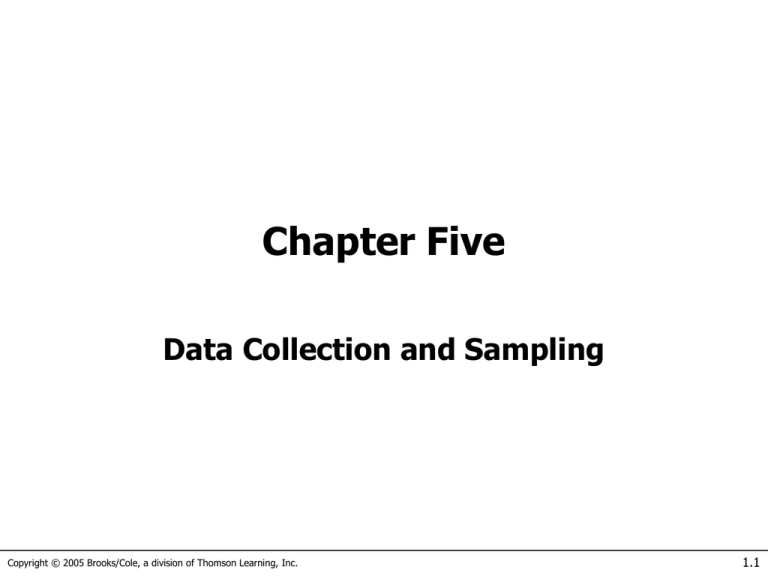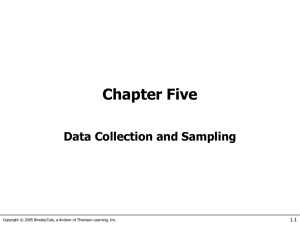Chapter 5 - Data Collection and Sampling
advertisement

Chapter Five Data Collection and Sampling Copyright © 2005 Brooks/Cole, a division of Thomson Learning, Inc. 1.1 Recall… Statistics is a tool for converting data into information: Statistics Data Information But where then does data come from? How is it gathered? How do we ensure its accurate? Is the data reliable? Is it representative of the population from which it was drawn? This chapter explores some of these issues. Copyright © 2005 Brooks/Cole, a division of Thomson Learning, Inc. 5.2 Methods of Collecting Data… There are many methods used to collect or obtain data for statistical analysis. Three of the most popular methods are: • Direct Observation • Experiments, and • Surveys. Copyright © 2005 Brooks/Cole, a division of Thomson Learning, Inc. 5.3 Surveys… A survey solicits information from people; e.g. Gallup polls; pre-election polls; marketing surveys. The Response Rate (i.e. the proportion of all people selected who complete the survey) is a key survey parameter. Surveys may be administered in a variety of ways, e.g. •Personal Interview, •Telephone Interview, •Self Administered Questionnaire, and •Internet Copyright © 2005 Brooks/Cole, a division of Thomson Learning, Inc. 5.4 Questionnaire Design… Over the years, a lot of thought has been put into the science of the design of survey questions. Key design principles: 1. Keep the questionnaire as short as possible. 2. Ask short, simple, and clearly worded questions. 3. Start with demographic questions to help respondents get started comfortably. 4. Use dichotomous (yes|no) and multiple choice questions. 5. Use open-ended questions cautiously. 6. Avoid using leading-questions. 7. Pretest a questionnaire on a small number of people. 8. Think about the way you intend to use the collected data when preparing the questionnaire. Copyright © 2005 Brooks/Cole, a division of Thomson Learning, Inc. 5.5 Sampling… Recall that statistical inference permits us to draw conclusions about a population based on a sample. Sampling (i.e. selecting a sub-set of a whole population) is often done for reasons of cost (it’s less expensive to sample 1,000 television viewers than 100 million TV viewers) and practicality (e.g. performing a crash test on every automobile produced is impractical). In any case, the sampled population and the target population should be similar to one another. Copyright © 2005 Brooks/Cole, a division of Thomson Learning, Inc. 5.6 Sampling Plans… A sampling plan is just a method or procedure for specifying how a sample will be taken from a population. We will focus our attention on these three methods: •Simple Random Sampling, •Stratified Random Sampling, and •Cluster Sampling. •Random sampling,by far, is the most common one used. Copyright © 2005 Brooks/Cole, a division of Thomson Learning, Inc. 5.7 Simple Random Sampling… A simple random sample is a sample selected in such a way that every possible sample of the same size is equally likely to be chosen. Drawing three names from a hat containing all the names of the students in the class is an example of a simple random sample: any group of three names is as equally likely as picking any other group of three names. VERY EASY TO DEFINE! VERY, VERY DIFFICULT TO DO! •Random sample of 100 cokes bottles today at the coke plant. •Random sample of 50 pine trees in a 1000 acre forest. •Random sample of 5 deer in a national forest. Copyright © 2005 Brooks/Cole, a division of Thomson Learning, Inc. 5.8 Simple Random Sampling… A government income tax auditor must choose a sample of 5 of 11 returns to audit…[Can do many different ways] Person baker george ralph mary sally joe andrea mark greg aaron kim Generate Random # 0.87487 0.89068 0.11597 0.58635 0.34346 0.24662 0.47609 0.08350 0.53542 0.37239 0.73809 Copyright © 2005 Brooks/Cole, a division of Thomson Learning, Inc. 1 2 3 4 5 Person mark ralph joe sally aaron andrea greg mary kim baker george Sorted Random # 0.08350 0.11597 0.24662 0.34346 0.37239 0.47609 0.53542 0.58635 0.73809 0.87487 0.89068 5.9 Stratified Random Sampling… A stratified random sample is obtained by separating the population into mutually exclusive sets, or strata, and then drawing simple random samples from each stratum. Strata 1 : Gender Male Female Strata 2 : Age < 20 20-30 31-40 41-50 51-60 > 60 Strata 3 : Occupation professional clerical blue collar other We can acquire about the total population, make inferences within a stratum or make comparisons across strata Copyright © 2005 Brooks/Cole, a division of Thomson Learning, Inc. 5.10 Stratified Random Sampling… After the population has been stratified, we can use simple random sampling to generate the complete sample: If we only have sufficient resources to sample 400 people total, we would draw 100 of them from the low income group… …if we are sampling 1000 people, we’d draw 50 of them from the high income group. Copyright © 2005 Brooks/Cole, a division of Thomson Learning, Inc. 5.11 Cluster Sampling… A cluster sample is a simple random sample of groups or clusters of elements (vs. a simple random sample of individual objects). This method is useful when it is difficult or costly to develop a complete list of the population members or when the population elements are widely dispersed geographically. Used more in the “old days”. Cluster sampling may increase sampling error due to similarities among cluster members. Copyright © 2005 Brooks/Cole, a division of Thomson Learning, Inc. 5.12 Sample Size… Numerical techniques for determining sample sizes will be described later, but suffice it to say that the larger the sample size is, the more accurate we can expect the sample estimates to be. Copyright © 2005 Brooks/Cole, a division of Thomson Learning, Inc. 5.13 Sampling and Non-Sampling Errors… Two major types of error can arise when a sample of observations is taken from a population: sampling error and nonsampling error. Sampling error refers to differences between the sample and the population that exist only because of the observations that happened to be selected for the sample. Random and we have no control over. Nonsampling errors are more serious and are due to mistakes made in the acquisition of data or due to the sample observations being selected improperly. Most likely caused be poor planning, sloppy work, act of the Goddess of Statistics, etc. Copyright © 2005 Brooks/Cole, a division of Thomson Learning, Inc. 5.14 Sampling Error… Sampling error refers to differences between the sample and the population that exist only because of the observations that happened to be selected for the sample. Increasing the sample size will reduce this type of error. Copyright © 2005 Brooks/Cole, a division of Thomson Learning, Inc. 5.15 Nonsampling Error… Nonsampling errors are more serious and are due to mistakes made in the acquisition of data or due to the sample observations being selected improperly. Three types of nonsampling errors: Errors in data acquisition, Nonresponse errors, and Selection bias. Note: increasing the sample size will not reduce this type of error. Copyright © 2005 Brooks/Cole, a division of Thomson Learning, Inc. 5.16 Errors in data acquisition… …arises from the recording of incorrect responses, due to: — incorrect measurements being taken because of faulty equipment, — mistakes made during transcription from primary sources, — inaccurate recording of data due to misinterpretation of terms, or — inaccurate responses to questions concerning sensitive issues. Copyright © 2005 Brooks/Cole, a division of Thomson Learning, Inc. 5.17 Nonresponse Error… …refers to error (or bias) introduced when responses are not obtained from some members of the sample, i.e. the sample observations that are collected may not be representative of the target population. As mentioned earlier, the Response Rate (i.e. the proportion of all people selected who complete the survey) is a key survey parameter and helps in the understanding in the validity of the survey and sources of nonresponse error. Copyright © 2005 Brooks/Cole, a division of Thomson Learning, Inc. 5.18 Selection Bias… …occurs when the sampling plan is such that some members of the target population cannot possibly be selected for inclusion in the sample. Copyright © 2005 Brooks/Cole, a division of Thomson Learning, Inc. 5.19









